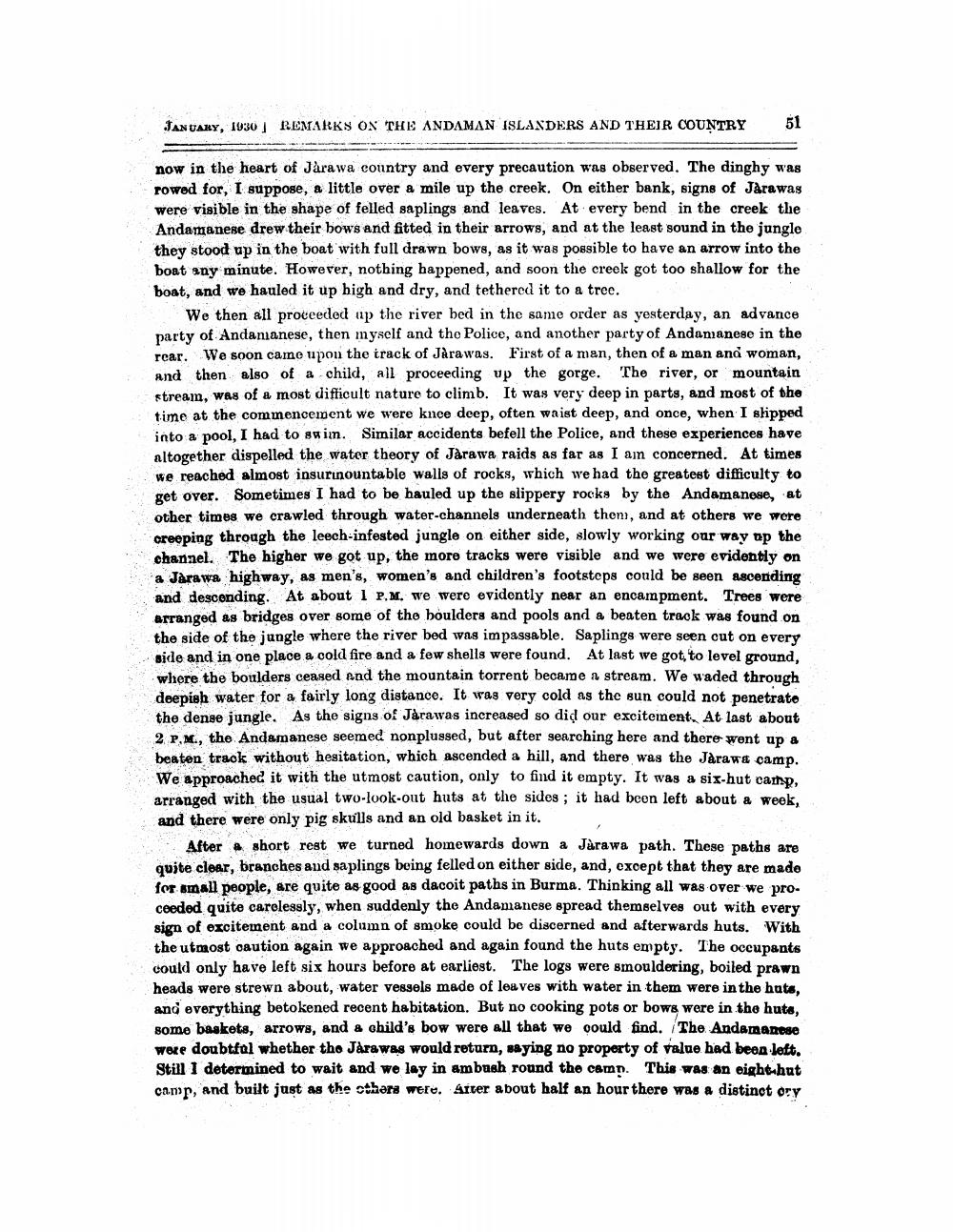________________
JANUARY, 1930] REMARKS ON THE ANDAMAN ISLANDERS AND THEIR COUNTRY
51
now in the heart of Jarawa country and every precaution was observed. The dinghy was rowed for, I suppose, a little over a mile up the creek. On either bank, signs of Jarawas were visible in the shape of felled saplings and leaves. At every bend in the creek the Andamanese drew their bows and fitted in their arrows, and at the least sound in the jungle they stood up in the boat with full drawn bows, as it was possible to have an arrow into the boat any minute. However, nothing happened, and soon the creek got too shallow for the boat, and we hauled it up high and dry, and tethered it to a tree.
We then all proceeded up the river bed in the same order as yesterday, an advance party of Andananese, then myself and the Police, and another party of Andamanege in the rear. We soon came upon the track of Jarawas. First of a man, then of a man and woman, and then also of a child, all proceeding up the gorge. The river, or mountain stream, was of a most difficult nature to climb. It was very deep in parts, and most of the time at the commencement we were knce deep, often waist deep, and once, when I shipped into a pool, I had to swim. Similar accidents befell the Police, and these experiences have altogether dispelled the water theory of Járawa raids as far as I am concerned. At times we reached almost insurinountable walls of rocks, which we had the greatest difficulty to get over. Sometimes I had to be hauled up the slippery rocks by the Andamanese, at other times we crawled through water-channels underneath them, and at others we were creeping through the leech-infested jungle on either side, slowly working our way up the channel. The higher we got up, the more tracks were visible and we were evidently on a Jarawa highway, as men's, women's and children's footsteps could be seen ascending and descending. At about 1 P.M. we were evidently near an encampment. Trees were arranged as bridges over some of the boulders and pools and a beaten track was found on the side of the jungle where the river bed was impassable. Saplings were seen cut on every side and in one place a cold fire and a few shells were found. At last we got to level ground, where the boulders ceased and the mountain torrent became a stream. We waded through deepish water for a fairly long distance. It was very cold as the sun could not penetrato the dense jungle. As the signs of Jarawas increased so did our excitement. At last about 2 PM., the Andamanese seemed nonplussed, but after searching here and there went up a beaten track without hesitation, which ascended a hill, and there was the Jarawa camp. We approached it with the utmost caution, only to find it empty. It was a six-hut camp, arranged with the usual two-look-out huts at the sides; it had been left about a week, and there were only pig skulls and an old basket in it.
After a short rest we turned homewards down a Jàrawa path. These paths are quite clear, branches and saplings being felled on either side, and, except that they are made for small people, are quite as good as dacoit paths in Burma. Thinking all was over we proceeded quite carelessly, when suddenly the Andamanese spread themselves out with every sign of excitement and a column of smoke could be discerned and afterwards huts. With the utmost caution again we approached and again found the huts empty. The occupants could only have left six hours before at earliest. The logs were smouldering, boiled prawn heads were strewn about, water vessels made of leaves with water in them were in the huts, and everything betokened recent habitation. But no cooking pots or bows were in the huta. some baskets, arrows, and a child's bow were all that we could find. The Andamanese were doubtfal whether tho Jarawas would return, saying no property of value had been left. Still I determined to wait and we lay in ambush round the camp. This was an eight hat camp, and built just as the others were. Siter about half an hour there was a distinct ory




